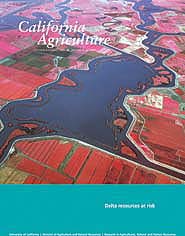Calag Archive
Calag Archive

Delta resources at risk
Cover:
Aquatic resources have been a critical component of California's growth and prosperity, but scientists warn that human uses have taxed these resources to the limit. Efforts are under way to restore aquatic ecosystems statewide.
Above, Mildred Island is a 1,000-acre "lake" formed in 1983 when large storms breached a levee and flooded a farm tract. Located in the interior San Joaquin-Sacramento River Delta, this site represents a shallow-water habitat type that will be constructed by CALFED to promote the recovery of native fish.
Research is helping to inform this effort. On page 104, scientists measure supplies of phytoplanton, an essential component of the Delta food web. Also, studies on biomarkers (page 110) aid in understanding how environmental factors affect Delta wildlife. Infared photo by Herb Lingl/aerialarchives.com .
October-December 2003
Volume 57, Number 4
Volume 57, Number 4


